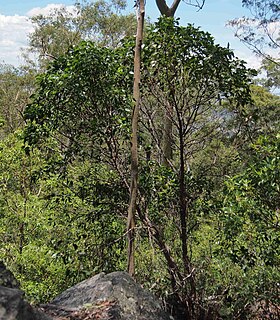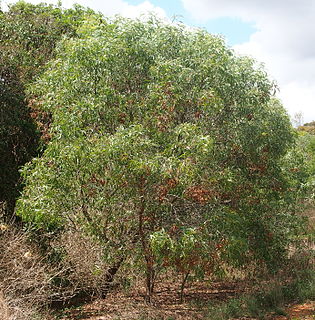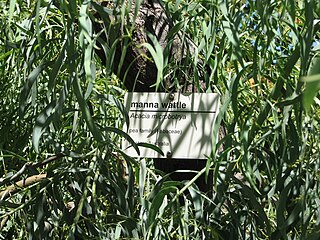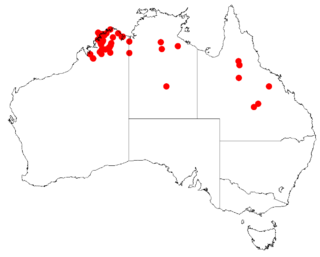
Acacia pycnantha, most commonly known as the golden wattle, is a tree of the family Fabaceae native to southeastern Australia. It grows to a height of 8 m (26 ft) and has phyllodes instead of true leaves. Sickle-shaped, these are between 9 and 15 cm long, and 1–3.5 cm wide. The profuse fragrant, golden flowers appear in late winter and spring, followed by long seed pods. Plants are cross-pollinated by several species of honeyeater and thornbill, which visit nectaries on the phyllodes and brush against flowers, transferring pollen between them. An understorey plant in eucalyptus forest, it is found from southern New South Wales and the Australian Capital Territory, through Victoria and into southeastern South Australia.

Acacia aulacocarpa, also known as New Guinea wattle or golden flowered salwood, is an Australian shrub or tree in the family Fabaceae. It is found in northern Australia, Papua New Guinea, Irian Jaya and parts of Indonesia.

Acacia complanata, known as long-pod wattle and flat-stemmed wattle, is a perennial tree native to eastern Australia.

Acacia triptera, commonly known as spurwing wattle, is an erect or spreading shrub which is endemic to Australia.

Acacia flexifolia, commonly known as bent-leaf wattle or small winter wattle, is a shrub species that is endemic to eastern Australia.

Acacia flavescens, also known as the red wattle, yellow wattle or primrose ball wattle, is a tree in the genus Acacia native to eastern Australia.

Acacia leptocarpa, commonly known as north coast wattle, is a shrub or small tree native to New Guinea and coastal regions of northern Australia.

Acacia retinervis is a tree or shrub belonging to the genus Acacia and the subgenus Juliflorae endemic to northern western Australia.

Acacia baxteri, commonly known as Baxter's wattle, is a shrub belonging to the genus Acacia and the subgenus Phyllodineae, and is endemic to the south west of Western Australia.

Acacia bidentata is a shrub belonging to the genus Acacia and the subgenus Phyllodineae and is native to Western Australia.

Acacia congesta is a shrub belonging to the genus Acacia and the subgenus Phyllodineae endemic to Western Australia.

Acacia microbotrya, commonly known as manna wattle or gum wattle, is a shrub or tree belonging to the genus Acacia and the subgenus Phyllodineae that is native to Western Australia.

Acacia obovata is a shrub belonging to the genus Acacia and the subgenus Phyllodineae that is endemic to south western Australia.

Acacia sphacelata is a shrub of the genus Acacia and the subgenus Phyllodineae that is endemic to south western Australia.

Acacia colletioides, commonly known as wait-a-while, pin bush and spine bush, is a shrub of the genus Acacia and the subgenus Plurinerves that is native to Australia.

Acacia sericata is a shrub or tree of the genus Acacia and the subgenus Plurinerves that is endemic across northern Australia.

Acacia conferta, commonly known as crowded-leaf wattle, is a shrub belonging to the genus Acacia and the subgenus Phyllodineae that is endemic to eastern Australia.

Acacia polystachya is a tree belonging to the genus Acacia and the subgenus Juliflorae that is native to north eastern Australia.

Acacia venulosa, commonly known as veiny wattle or veined wattle, is a shrub of the genus Acacia and the subgenus Plurinerves that is endemic to an area of eastern Australia.

Acacia viscidula, also known as sticky wattle, is a shrub of the genus Acacia and the subgenus Plurinerves that is endemic to an area of eastern Australia.




















